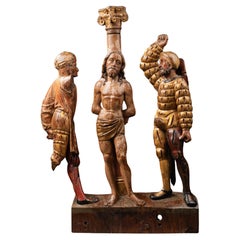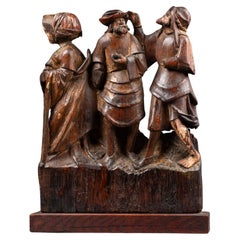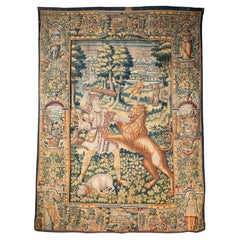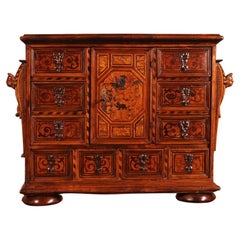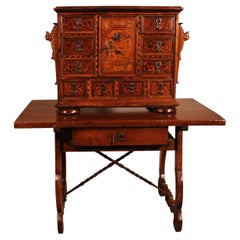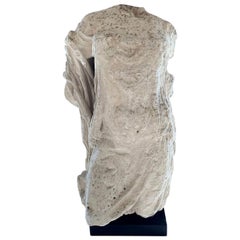Antiques in Brussels
to
4
1,050
494
3,457
2,060
1,074
852
782
560
497
373
271
255
181
158
120
97
96
91
74
62
52
45
37
34
32
28
18
15
14
12
10
4
4
3
3
2
2
2
2
2
1
1
1
1
1
1
Period: 16th Century
The flagellation - Brabant, circa 1560
Located in Bruxelles, BE
Altarpiece group representing the flagellation
Brabant, circa 1560-1580
Carved wood, polychrome, and gilded
50 x 38 x 7 cm
At the center of the group, Christ stands upright, leaning...
Category
16th Century Belgian Renaissance Antique Antiques in Brussels
Materials
Wood
Group of Altarpiece - Antwerpen, 16th century
Located in Bruxelles, BE
Group of altarpiece representing the life of a Saint, Saint Renualde?
Engraved by the sign of Antwerp hand on the hat of the central character
Carved oak, traces of polychromy
Fir...
Category
16th Century Belgian Renaissance Antique Antiques in Brussels
Materials
Oak
renaissance wooden candelabrum and painted cross - Umbria, 16th century
Located in Bruxelles, BE
Base of a carved wooden candelabrum, polychrome and gilded; cross painted on both sides.
Umbria or Tuscany, 16th century
136 x 43,5 x 30 cm
(The cross and the base of the candelabrum were later assembled)
The base of the candelabrum is intricately carved and adorned with polychrome and gilded finishes. The shafts take on the shape of balusters reminiscent of ancient columns, feature ornate foliage decorations, garlands and winged cherub faces. The feet are crafted in the likeness of lion paws. The base is further embellished with depictions of four saint martyrs, among them Saint Barbara and Saint Catherine of Alexandria. The plasticity of the figures, outlined with strong contour lines, the clear and vibrant colors, are stylistic elements linked to the Umbrian tradition of the sixteenth century.The precisely defined and elegant drawing, along with the clear color palette applied with refined chiaroscuro modulations, became the signature of a style that would leave a lasting mark on the era to come. This is exemplified by a preference for vibrant, multicolored images, accentuated in this case by the use of red and pink in the saint's attire.
A notable addition, introduced later, is a polylobed cross painted on both sides. On one side, the Crucifixion is vividly portrayed:The treatment of the corpus itself is in line with High Medieval practice, emphasizing pathos by showing Jesus dead, his arms sagging from the weight of the body. The upper section displaying a pelican pecks at her breast to feed her young with her own blood; a symbol of the sacrifice of Christ on the cross whose body and blood similarly nourishes the celebrant during Mass.
The lower part depicts Golgotha. On the reverse side, the Resurrection is artistically presented in a Renaissance iconography, reminiscent of the renowned composition painted by Piero della Francesca, now housed in the Civic Museum of Sansepolcro. In terms of composition, with the frontal depiction of Christ holding the banner, this motif became particularly widespread in central Italy, spanning from Tuscany to Umbria throughout the 16th century..
The double-sided construction suggests that it may also have been carried in liturgical processions. In Umbria from the 14th century, the use of portable crosses painted on both sides had become a widespread practice, aimed at satisfying the monastic clientele that had significantly increased following the establishment of new religious communities.
The earliest surviving Tuscan painted crucifix represent Christ as Christus Triumphans, or the “Triumphant Christ” with his head up and eyes open. This form was supplanted in the 13th century with the Christus Patiens, or “Suffering Christ” type who is shown often with his head fallen on his shoulder and his eyes closed, as In our cross. The iconography of the suffering Christ appears to have developed out of a new interest in Christ’s human nature, the development of the feast of Corpus Christi and with increased importance given to the Eucharist. The process of humanizing the figure of Christ reaches its peak with the abandonment of all the previous expressive conventions in favor of more realistic details we can observe in this Crucifix, such as the swollen belly, the arms stretched to the limit of muscle tearing, the body falling heavily forward, the abundant blood on
the wounds, and the cross firmly embedded in the rock of Calvary.
It's worth noting that Renaissance candelabra...
Category
16th Century Italian Renaissance Antique Antiques in Brussels
Materials
Wood, Giltwood
16th century Brussels tapestry - The Story of David
Located in Bruxelles, BE
16th century Brussels tapestry
The Story of David
Brabant, 16th Century
Monogram at the bottom left.
320 x 250 cm
This splendid Brussels tapestry, crafted from wool and silk during ...
Category
16th Century Belgian Renaissance Antique Antiques in Brussels
Materials
Wool, Silk
Black Forest Cabinet Dated 1590
Located in Brussels, Brussels
Very beautiful German cabinet probably black forest dated 1590 in walnut.
The drawers as well as the door have superb chiseled locks. Which is a monumental work and a sign of the be...
Category
16th Century German Renaissance Antique Antiques in Brussels
Materials
Walnut
Black Forest Cabinet Dated 1590 With Its Base
Located in Brussels, Brussels
Very beautiful German cabinet probably black forest dated 1590 in walnut.
The drawers as well as the door have superb chiseled locks. Which is a monumental work and a sign of the be...
Category
16th Century German Renaissance Antique Antiques in Brussels
Materials
Walnut
16th Century Cast Iron Mortar
Located in Brussels, Brussels
16th century cast iron mortar with two very beautiful handles
Beautiful original object with a great patina and in very good condition.
Category
16th Century French Renaissance Antique Antiques in Brussels
Materials
Iron
Italian Renaissance Walnut Chest -16 ° Century
Located in Brussels, Brussels
Superb chest called cassone in walnut from the 16th century from the Italian Renaissance
Very beautiful large chest in walnut where each side is made up of a single board which is a...
Category
16th Century Italian Renaissance Antique Antiques in Brussels
Materials
Walnut
Agnolo di Polo Firenze 1470 - Arezzo 1528' - Saint Nicholas of Tolentino
Located in Bruxelles, BE
Agnolo di Polo (Firenze 1470 - Arezzo 1528)
Saint Nicholas of Tolentino
Around 1510-1520
Painted and gilded terracotta
55.5 x 24 x 16.5 cm
San Nicholas de Tolentino is represe...
Category
16th Century Italian Renaissance Antique Antiques in Brussels
Materials
Terracotta
Florentine Leather Casket, 16th Century
Located in Bruxelles, BE
Florentine leather casket
Italy, Tuscany
16th century
leather, iron and wood.
Very rare boiled leather box incised on a wooden core; iron lock.
The central shield is divide...
Category
16th Century Italian Renaissance Antique Antiques in Brussels
Materials
Iron
Bronze Pot, 16th Century
Located in Brussels, Brussels
Superb Flemish Renaissance bronze pot from the 16th century.
Superb patina and in very good condition.
Category
16th Century Belgian Renaissance Antique Antiques in Brussels
Materials
Bronze
Wooden Statue of a Monk with a Bible and a Ciborium, 16th Century
Located in Brussels, Brussels
very beautiful oak sculpture representing a monk with a ciborium and a bible in hand - Germany -16 century
Old trace of polychromy
Sculpture of good quality with fine hands, be...
Category
16th Century German Renaissance Antique Antiques in Brussels
Materials
Oak
Griffin Head, Italy, 16th Century
Located in Bruxelles, BE
Griffin head
Italy, 16th century
On a modern metal stand
Measures: 20 x 29 x 21 cm (without the stand)
The griffin is a legendary creature with the body of a lion, the head an...
Category
16th Century Italian Renaissance Antique Antiques in Brussels
Materials
Marble
Fra Mattia Della Robbia, Saint Joseph, Tuscany, Around 1505-1510
By Della Robbia
Located in Bruxelles, BE
Fra Mattia Della Robbia (Firenze 1468-1534)
Saint Joseph
Terracotta
Tuscany, around 1505-1510
55 x 40 x 30 cm
Marco della Robbia the Younger (April 6, 1468 in Florence - 15...
Category
16th Century Italian Renaissance Antique Antiques in Brussels
Materials
Terracotta
Rare Offering Basket or Basin Germany-16th Century in Brass
Located in Brussels, Brussels
Rare basin (We think it was the basin to wash the feet on hollyThursday) in brass
Rare plat of the german renaissance since it is rather a basin which is much rarer than a offerin...
Category
16th Century Renaissance Antique Antiques in Brussels
Materials
Brass
Bronze Mortar, Tuscany, Second Half of 16th Century
Located in Bruxelles, BE
Bronze mortar with garlands, flowers and putti - Tuscany , second half of 17th century.
Measures: height 10
diameter : 13 cm
Artisans and healers used mortars for grinding food...
Category
16th Century Italian Renaissance Antique Antiques in Brussels
Materials
Bronze
Henri II Table in Walnut, 16th Century
Located in Brussels, Brussels
Superb and rare Henri II oval table in walnut from the 16th century.
Very beautiful collector's table with a walnut table top which has a very beau...
Category
16th Century French Renaissance Antique Antiques in Brussels
Materials
Walnut
Rare Pair of Venetian Sitting Mastiffs Dogs
By Venetian School
Located in Bruxelles, BE
Rare pair of sitting Mastiffs dogs.
Venice, end of 15th century - first half of the 16th century.
Istrian stone.
Provenance:
- Important private collection of an architect and scenographer from Orvieto (Umbria)
A regular exportation licence delivered by the Italian Ministry of Culture accompanies the work.
The representation of the dog dates back to ancient times, when dogs were considered weapons of war and used to attack the enemy or stand guard to protect strategic locations. At the entrance to the Pompei’s villa, the presence of a "cave canem...
Category
16th Century Italian Renaissance Antique Antiques in Brussels
Materials
Stone
Massacre of the Innocents, Normandy, Late 16th Century
Located in Bruxelles, BE
The Massacre of the Innocents
Carved oak panel
Normandy, late 16th century
(Collection labels on the back)
Measures: 43,5 x 61 cm.
Category
16th Century French Renaissance Antique Antiques in Brussels
Materials
Oak
Prie-Dieu or Oratory in Walnut and Burl Walnut, circa 1600
Located in Brussels, Brussels
Elegant oratory or prieu dieu (prayer Kneeler) in walnut and burr walnut from northern Italy circa 1600
Very beautiful Italian Renaissance furniture...
Category
16th Century Italian Renaissance Antique Antiques in Brussels
Materials
Walnut
Cercle of Romano Alberti, Page, Around 1530-1540
Located in Bruxelles, BE
Cercle of Romano Alberti, dit Il Nero da Sansepolcro ( San Sepolcro, 1521-1568 )
Page
Mixed media : wood core, papier mâché, stucco, polychrome and gilded
Italy, around 1530-154...
Category
16th Century Italian Renaissance Antique Antiques in Brussels
Materials
Stucco, Wood, Paper
16th Century Walnut Sculptures from Germany
Located in Brussels, Brussels
Very elegant sculpture reprenting a Putti (angel) from the German renaissance period -16 century
Rare sculpture in walnut of great quality with a very beau...
Category
16th Century German Renaissance Antique Antiques in Brussels
Materials
Walnut
Mortar and Pilar End 15th Century Gothic Period
Located in Brussels, Brussels
Iron mortar with its original pestle end 15th beginning 16th century Gothic period, France
Beautiful original object with a beautiful patina and in good condition
Category
16th Century French Gothic Antique Antiques in Brussels
Materials
Iron
16th C, Biblical, Manner of Joos van Cleve, Madonna with Child, Oil on Panel
By Joos van Cleve
Located in brussel, BE
Attentive observer, may I challenge you to find some unusual elements in this panel painting? One detail has to do with the symbolic use of color, the other with a later adjustment of the image. Indeed! The Blessed Virgin is not dressed in her usual sky blue cloak, which refers to her purity, but in a red robe.
During the Late Middle Ages and early Renaissance, the Virgin often wore such a red garment to refer to the Passion of Christ. After all, the blessing Christ child with his orb would shed his blood for the redemption of mankind. The second strange element catches the eye when one looks closer at the little Jesus. It appears that he was originally depicted completely naked, but got on a transparent loincloth over time. In the past there were several times when nudity in art was subject to some form of censorship. For example, the supervision of Christian art was strongly encouraged by the Council of Trent (1545-1563). This assembly was dealing with the inner-ecclesiastical reform of the Roman Catholic Church. One of the important theologians who followed the council’s guidelines was Joannes Molanus (1533-1585). He did not consider the nakedness of the Christ Child to be edifying and pointed out that children could be endangered in this way. He may have been referring to the dangers of paedophilia.
During the 19th century, puritanism emerged. A famous example of a moral preacher was Pope Pius IX...
Category
16th Century Baroque Antiques in Brussels
Materials
Canvas, Oil
Renaissance Spanish Occassional Table circa 1600 in Walnut
Located in Brussels, Brussels
Spanish Renaissance walnut table circa 1600
Sublime small table with a beautiful large walnut top.
Very interesting base with turned le...
Category
16th Century Spanish Renaissance Antique Antiques in Brussels
Materials
Walnut
Iron Mortar, circa 1600 with Its Original Base
Located in Brussels, Brussels
Interesting iron mortar with its original base
French Renaissance mortar, circa 1600
This beautiful object is composed of its iron mortar which is 28cm high and its base which ...
Category
16th Century French Renaissance Antique Antiques in Brussels
Materials
Iron
Pair of Eagles 16th Century from North Italy Church Lectern
Located in Brussels, Brussels
Exceptional pair of aigles of the 16th century of Italy
Superbe pair of wooden sculpted aigles from the Italian Renaissance. Very Fine and delicate sculpture
The pair of eagles se...
Category
16th Century Italian Renaissance Antique Antiques in Brussels
Materials
Giltwood
Louis XV Style Patinated Console With Its Marble
Located in Brussels, BE
Louis XV Style Patinated Console With Its Marble
Category
16th Century Louis XVI Antique Antiques in Brussels
Materials
Marble
Related Items
16th Century Madonna and child wood carving
Located in Bakewell, GB
16th Century Madonna and child wood carving, retaining some original polychrome decoration
sizes 67 cms high, 30cms wide and 25 cms deep
Category
16th Century Antique Antiques in Brussels
Materials
Wood
16th Century Stone Classical Roman Style Torso
Located in Vosselaar, BE
A wonderful 16th century draped female torso in classical style. Made in France under Italian Renaissance influence this female torso is finely sculpted with great detail to the stol...
Category
16th Century French Renaissance Antique Antiques in Brussels
Materials
Sandstone
The ‘CAVALIER ARAB’, Circa 1880
By Alfred Barye, Émile Guillemin
Located in London, GB
"Cavalier Arabe”, which is a collaboration by two French sculptors Alfred Barye and Emile-Coriolan-Hippolyte Guillemin. Signed by E Guillemin and Bary f...
Category
Late 19th Century French Belle Époque Antique Antiques in Brussels
Materials
Spelter
Spanish Sculpture "Pieta" 16th Century
Located in Madrid, ES
Spanish sculpture "Pieta"
16th century
sculpture in stone
Nossa Senhora, is represented seated securing Jesus Christ.
Measure: Height: 52 cm.
Very good condition.
Category
16th Century Spanish Gothic Antique Antiques in Brussels
Materials
Stone
Lion of Forge, Spain, 16th Century
By Europa Antiques
Located in Madrid, ES
Lion of Forge, Spain, 16th century
In forging, measurements: 10 x 17 x 5 cm
Good condition
Spanish private collection.
Category
16th Century Spanish Baroque Antique Antiques in Brussels
Materials
Iron
Male Head, Carved Stone, Spain, 16th Century
Located in Madrid, ES
Male head. Carved stone. Century XVI.
Carved stone relief showing a male face turned to the right. It is necessary to highlight both the quality of the fac...
Category
16th Century Spanish Renaissance Antique Antiques in Brussels
Materials
Stone
Saint Paul, Carved and Polychromed Wood. Spanish School, 16th Century
Located in Madrid, ES
Spanish school of the sixteenth century. "Saint Paul". Carved and polychrome wood.
Devotional image of a round piece carved in wood, polychrome and gilded, representing the Apostle ...
Category
16th Century Spanish Renaissance Antique Antiques in Brussels
Materials
Other
Misericord. Carved wood. 16th century.
Located in Madrid, ES
Choir Mercy. Carved wood. Century XVI.
Carved wooden Misericordia that surely belonged to a choir stall (see the upper flat part, which acts as a seat), decorated with a figurative ...
Category
16th Century European Renaissance Antique Antiques in Brussels
Materials
Other
Winged angel head. Polychrome wood. Spanish school, 16th century.
Located in Madrid, ES
Winged angel head. Polychrome wood. Spanish school, 16th century. Carved and gilded wooden sculpture that shows a child's head with blonde, curly hair adorned with two wings. This ty...
Category
16th Century European Renaissance Antique Antiques in Brussels
Materials
Other
Japanese Wooden Buddhist Sculpture of Amida Nyorai, 16th Century
Located in Milano, IT
The Amitabha (Amida in Japanese) Buddha is shown standing with his hands forming the Amida raigo-in mudra. The face has a serene expression, with closed eyes under delicately arched brows and a severe face. The hair is arranged in rows of coils that also cover the "ushnisha", the protuberance on the head. The drapery is folded in elegant pleats falling from the shoulders to the feet. The antique sculpture is placed on a lotus flower which is located on a richly decorated base.
Faith in Amida Buddha remained largely confined to a small segment of the Japanese population until the Kamakura Era (1185-1333) when it was popularized by new Pure Land sects committed to bringing Buddhism to the illiterate commoner. These sects expressed concern for the salvation of the ordinary person and stressed pure and simple faith over complicated rites and doctrines. Amida Nyorai...
Category
16th Century Japanese Antique Antiques in Brussels
Materials
Wood
Antique 19th Century Swiss Black Forest Hanging Cabinet / Small Cabinet Oak Bird
Located in Ijzendijke, NL
Stunning 19th century Swiss black forest hanging cabinet / small cabinet carved from solid oak.
Superb Black Forest cabinet with floral carvings displaying leaves & acorns. The doo...
Category
1870s Swiss Black Forest Antique Antiques in Brussels
Materials
Oak
Free Shipping
H 17.92 in W 15.75 in D 9.65 in
Italian Ancient Marble Sculpture Fountain, Late 16th Century
Located in Milano, IT
Sea monster
Carrara marble mouth fountain
Italy, late 16th century
It measures 13.8 x 31.5 x 18.9 in (35 x 80 x 48 cm)
State of conservation: some small evident gaps and widespread signs of wear due to outdoor exposure. The gray marks crossing it do not come from restoration, but are rather the natural veins of the marble.
This work has some morphological characteristics typically associated with the iconography of the sea monster: an elongated muzzle, sharp teeth, protruding eyes, elongated ears, and a coiled serpent's tail.
An in-depth series of studies on artistic depictions of the sea monster attempted to verify how this symbol evolved in antiquity in the European and Mediterranean contexts and how it gradually changed its image and function over time. The iconography itself is mutable and imaginative and its history is rich with cultural and artistic exchange, as well as the overlapping of ideas. This occurred so much that it is difficult to accurately pinpoint the "types" that satisfactorily represent its various developments.
However, we can try to summarize the main figures, starting from the biblical Leviathan and the marine creature that swallowed Jonah (in the Christian version, this figure was to become a whale or a "big fish", the “ketos mega”, translation of the Hebrew “dag gadol”). Other specimens ranged from the dragons mentioned in the Iliad (which were winged and had legs) to "ketos” (also from Greek mythology), the terrifying being from whose Latinized name (“cetus”) derives the word "cetacean". See J. Boardman, “Very Like a Whale” - Classical Sea Monsters, in Monsters and Demons in the Ancient and Medieval Worlds, in Papers presented in Honor of Edith Porada, Mainz am Rhein 1987, pp. 73-84).
In Italy the monster underwent yet further variations: it can be found in Etruscan art on the front of some sarcophagi representing the companion of souls, while among the Romans we find the “Pistrice” (cited by Plinio in Naturalis Historia PLIN., Nat., II 9, 8 and by Virgilio in Eneide: VERG., Aen., III, 427), which appeared in the shape of a stylized hippocampus or a very large monstrous cetacean and evolved into a hideous being with a dragon's head and long webbed fins.
During the Middle Ages, the sea monster was the object of new transformations: at this time, it is often winged, the head is stretched like a crocodile, the front legs are often very sharp fins - sometimes real paws - until the image merges with dragons, the typical figures of medieval visionary spirituality widely found throughout Europe (on this topic and much more, see: Baltrušaitis, J., Il Medioevo fantastico. Antichità ed esotismi nell’arte gotica, Gli Adelphi 1997).
In Italy during the 15th and 16th centuries, the revival of classicism - representative of the humanistic and Renaissance periods - led to a different reading of these "creatures". Indeed, the sea monster was also to find widespread use as an isolated decorative motif, especially in numerous fountains and sculptures where dolphins or sea monsters were used as a characterizing element linked to water (on this theme see: Chet Van Duzer, Sea Monsters on Medieval and Renaissance Maps, London, The British library, 2013).
From the morphological point of view, the "sea monsters" of this period are mostly depicted as hybrid figures, in which the body of a mythological or real being (a hippocampus, a sea snake, a dolphin), is joined to a head with a rather indistinct appearance. It was usually characterized by large upright ears, an elongated snout, sharp teeth and globular, protruding eyes; a complex and indefinite figure, both from the symbolic point of view and from that of its genesis.
The work we are examining is placed as a cross between the medieval sea serpent and the Renaissance dolphin, with stylistic features which recall the snake as often used in heraldry (such as the "snake" depicted in the coat of arms of the Visconti - the lords and then dukes of Milan between 1277 and 1447 - and which, for some, may be derived from the representations of the “Pistrice” that swallowed Jonah).
In the search for sources, Renaissance cartography and in particular woodcuts should not be neglected. See for example the monsters of Olaus Magnus, from the editions of the “Historia de gentibus septentrionalibus” (“History of the peoples of the north”) and the natural histories of Conrad Gesner, Ulisse...
Category
16th Century Italian Renaissance Antique Antiques in Brussels
Materials
Carrara Marble
Previously Available Items
Follower of Andrea Sansovino (1460-1529) - Saint Jean the Baptist
Located in Bruxelles, BE
Follower of Andrea Sansovino (1460-1529)
Saint Jean the Baptist
White marble
Tuscany, 16th century
24 x 23 x 10 cm
(Nose restored)
Saint John the Baptist was the last of the Old Te...
Category
16th Century Italian Renaissance Antique Antiques in Brussels
Materials
Marble
Louis XV Style Patinated Console With Its Marble
Located in Brussels, BE
Louis XV Style Patinated Console With Its Marble
Category
16th Century Louis XVI Antique Antiques in Brussels
Materials
Marble
Guglielmo Della Porta Workshop, Christ Crucified
Located in Bruxelles, BE
Guglielmo della Porta workshop
Christ crucified
Rome, 1570-1575
Bronze, lost wax
39.5 x 35 cm
Beautiful patina
Figure representing Christ dead, ...
Category
16th Century Italian Renaissance Antique Antiques in Brussels
Materials
Bronze
Set of Six Bronze Handles, Italy, 16th Century
Located in Bruxelles, BE
Set of six chiseled bronze handles decorated with mermaids and mascarons
Central Italy, 16th century
Bronze
Measures: 11.4 x 12 x 8cm
Finely ...
Category
16th Century Italian Renaissance Antique Antiques in Brussels
Materials
Bronze
Renaissance Tabernacle Front - Tuscany, first half of the 16th century
Located in Bruxelles, BE
Beautiful tabernacle in the form of an antique facade of a single large level, crowned by S-shaped scrolls. The relief features a vertical axis of symmetry to create a space imbued with classical sobriety: the arcade flanked by pilasters evokes Roman triumphal arches; the presence of the Ionic capitals decorated with acanthus leaves is a direct quote from Roman architecture; the two volutes at the top are inspired by motifs borrowed from antiquity which became a very popular architectural feature during Renaissance.
A semicircular tympanum decorated with a shell crowned by an arch engraved with the inscription "Panis Vite celestis" ("the bread of celestial life") breaks the monotony of the straight line and clearly marks the place of the door where the host was kept.
The shell was, in Roman art, a symbol of life and resurrection. This symbolism linked to birth and regeneration is constantly repeated in the evangelical iconography.
Two engraved two-tone columns frame the central opening and shows decorations which exalt the liturgical function of the work: the chalice with the host is a clear reference to the rite of communion and to the Corpus Christi which was kept in the tabernacle. On the opposite side, classical forms are borrowed and adapted to the Christian symbolism: the ship represents the Church itself; the dolphins, here represented in a grotesque form combining heterogeneous elements, are one of the symbols identified with Jesus by the early Christians; the base on which the ship leans are in the shape of a vase with two handles of ancient inspiration. As Alberti said in his book of Re Aedificatoria, "this does not mean a paganization of Christianity but a Christianization of pagan antiquity".
The lower part of the tabernacle presents a floor with a geometric design combining rectangular, circular and oval figures in a chromatic contrast which accentuates the perspective.
One reason why architecture appears so frequently in Italian Renaissance works is that the depiction of buildings was particularly desirable at a time when artists were learning and demonstrating their ability to work with a perspectival system. To display the full range of perspectival skills, the artist needed to include measured space bounded by geometric and rectilinear forms which proclaimed their scale and proportions. A paved floor was an ideal ground to establish the base for the correct diminution of forms receding into distance.
The chromatic contrast between the light stone and the parts made in black stucco enlivens the relief and fits perfectly into the aesthetic ideals of Tuscan renaissance architecture. The bicromismo exalts the geometric harmony of the facades in accordance with Vitruvio's rules and is inspired by the marble inlays that covered many Roman architectures.
The contrast also made the relief easily readable from afar and drew the attention of the faithful to communion, the central moment of the Christian rite.
The technique used for the decoration is the "tarsia" or inlay, which consists of hollowing out the stone to inlay pieces of another material in it and embellish the surface of the work. The most decisive influence on development of intarsia was the emergence of the theory of linear perspective, a means of producing two-dimensional representations of the three-dimensional visual word. This non-contiguous technique was used especially by master cabinet makers and represented in the Renaissance one of the essential manifestations of the evolution of taste as well as a privileged way to apply the recently discovered laws of perspective. Intarsia revetements became an integral part of Tuscan decorative tradition both in architecture and in interiors furnishings. As André Chastel has shown: "The expansion of the intarsio is not just an episode of the interior design; the new technique is located at the crossroads of all the arts. The marquetry seems to have preceded the painting; finally, through the systematic administration of geometric shapes and perspective settings, it is closely linked to the theme of the "architectural view". It is possible to recognize a central phenomenon of the period ".
This tabernacle was made with the same technique used for the floor of San Miniato al Monte also called “a risparmio” (literally saving technique) in contraposition to the “a campitura” technique: the spaces left hollow from the carving are filled with niello, a special substance also used in goldwork. Niello is a black, pitch-based mixture that serves to emphasize the design.
This black paste...
Category
16th Century Italian Renaissance Antique Antiques in Brussels
Materials
Stone
H 28.75 in W 16.54 in D 3.55 in
Renaissance Chest in Walnut, 16th Century, France
Located in Brussels, Brussels
Superb and rare Renaissance chest in walnut from the 16th century
Very beautiful chest from the French Renaissance in carved walnut
Superb facade and sides in carved walnut
It has...
Category
16th Century French Renaissance Antique Antiques in Brussels
Materials
Walnut
French Renaissance God Lamp 16th Century in Bronze
Located in Brussels, Brussels
Exceptional bronze god lamp of the French Renaissance, 16th century
The whole lamp is entirely original with its original chain
Museum quality
beautifu...
Category
16th Century French Renaissance Antique Antiques in Brussels
Materials
Bronze
Spanish 16th Century Console or Sofa Table in Walnut and Chestnut
Located in Brussels, Brussels
Superb Spanish Table in walnut and chestnut of the end of the 16th century of the Spanish renaissance which has two drawers with his original handles as well as original locks.
Supe...
Category
16th Century Spanish Renaissance Antique Antiques in Brussels
Materials
Walnut
16th Century Pair of Candlesticks North of Italy
Located in Brussels, Brussels
Beautiful pair of bronze candlesticks from the 16th century from north of Italy.
Beautiful piece in melted bronze with a wrought iron spike.
Rare pair with a total height of 43cm...
Category
16th Century Italian Renaissance Antique Antiques in Brussels
Materials
Bronze
Spanish Walnut Occasional Table, 16th Century
Located in Brussels, Brussels
Spanish Renaissance walnut table circa 1600
Sublime occasional table with a beautiful large walnut top.
Very interesting base with straight legs that bring a nice balance to this...
Category
16th Century Spanish Renaissance Antique Antiques in Brussels
Materials
Walnut
Beautiful 16th Century Statue of St. Nicholas in Carved Stone
Located in Brussels, BE
Beautiful 16th century statue of St. Nicholas in carved stone.
Category
16th Century French Gothic Antique Antiques in Brussels
Materials
Stone
